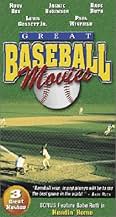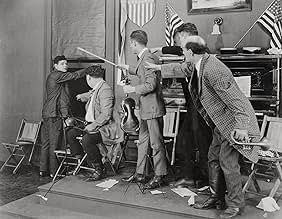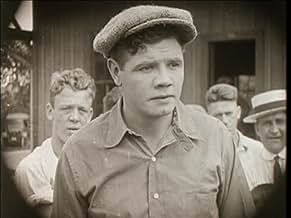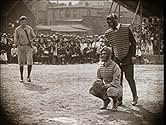Füge eine Handlung in deiner Sprache hinzuThe "true story" of baseball great Babe Ruth; Ruth plays himself.The "true story" of baseball great Babe Ruth; Ruth plays himself.The "true story" of baseball great Babe Ruth; Ruth plays himself.
- Regie
- Drehbuch
- Hauptbesetzung
Ralf Harolde
- John Tobin
- (as Ralph Harolds)
Charles Byer
- David Talmadge
- (as Charles Burt)
Ann Brody
- Mrs. Tony Marino
- (as Anne Brodie)
Sammy Blum
- Jimbo Jones
- (as Sam Blum)
Tom Cameron
- Deacon Flack
- (as Thomas Cameron)
Empfohlene Bewertungen
For anyone wanting to find out about the real life Babe Ruth, this "true story" should be avoided at all costs! Created in 1920, this film purports to be about the Bambino and his rise to fame, but frankly almost none of it bears any similarity to the slugger. In the film, he's a small town boy who is shy and unassuming. In real life, he grew up in the "rustic small town" of Baltimore, Maryland and was a bit of a juvenile delinquent--but I guess this image makes for a rather unappealing film! Now the fact that they played so fast and loose with the facts wasn't totally awful--after all, many of our heroes of times past have an aura of fiction about them. But the fiction they created is so schmaltzy and saccharine that it becomes almost laughable. Babe does practically everything in the film but walk on water and heal the sick! The fact that many at the time believed this is what is so amazing about this film. The only truth in the film is that the writers describe his as ugly--something I am surprised Ruth allowed. I guess he wasn't too hung up about his looks.
Speaking of looks, Babe is quite young in the film--and rather trim after his first season with the Yankees. Oddly, though, he'd been a very famous pitcher with the Red Sox but this is never alluded to in the film--but his prowess with the bat sure is. In fact, in the movie he made the bat himself--something reminiscent of Robert Redford's character in THE NATURAL.
Now I am sure you gather that the historical aspects of this film are dubious, at best. As for the entertainment value and quality of the film, it's not bad--especially for 1920. While people today will most likely laugh at the silly and over-the-top plot, the audience of 1920 ate it up and the film was well-produced and kept my interest.
Overall, I give it a 7 as entertainment and a 1 for historical accuracy!
Speaking of looks, Babe is quite young in the film--and rather trim after his first season with the Yankees. Oddly, though, he'd been a very famous pitcher with the Red Sox but this is never alluded to in the film--but his prowess with the bat sure is. In fact, in the movie he made the bat himself--something reminiscent of Robert Redford's character in THE NATURAL.
Now I am sure you gather that the historical aspects of this film are dubious, at best. As for the entertainment value and quality of the film, it's not bad--especially for 1920. While people today will most likely laugh at the silly and over-the-top plot, the audience of 1920 ate it up and the film was well-produced and kept my interest.
Overall, I give it a 7 as entertainment and a 1 for historical accuracy!
Boy howdy, if this isn't a trip through time, and maybe even more so than other works of the silent era. Porkpie hats galore; effusive intertitle representation of colloquial phrases, slang, and dialects that are practically another language one century later; self-mythologizing that makes T. E. Lawrence's exaggerations of his escapades look like a little white lie. And to top it all off, 'Headin' home' is a fictionalized biography that is presented as loose narrative fiction, with focus at times on tertiary figures who have nothing to do with the man himself! Very light "comedy," and very light "drama," are really nothing more than an excuse to give baseball legend Babe Ruth his own movie - and at times, it seems, to allow the folks writing the intertitles to let their imagination run wild, seemingly with the aid of several bottles of a favored alcohol beverage.
Neither Ruth, nor writers Arthur "Bugs" Baer or Earle Browne, nor director Lawrence C. Windom were a Buster Keaton or a Harold Lloyd, and this flick is no exemplar of humor or of this period in cinema. Anyone who isn't already enamored of silent films may not find anything here to change their mind. Be that as it may, it's modestly enjoyable on its own merits, and there are some small bits and pieces that are unexpectedly keen. The writers may have been imbibing a brew or five while penning the intertitles, but every now and again they slip in an especially witty line, such as a reference to the League of Nations and Woodrow Wilson's peace plan following World War I, or sly wordplay. Some scenes herein would fit neatly within a feature from a contemporary comedic icon, and for that matter - replace the central sports figure with any other actor, and at once the storytelling in 'Headin' home' would both be less noteworthy, but also right in line with most any picture of 1920. Granted, I think the story is a tad unfocused, and maybe even scattered; there are also instances where the contemporary references in the intertitles are so firmly cemented that a modern viewer can only make inferences as to the full meaning. All the same, these criticisms are no worse than can be said for what other writers have conjured.
In addition to old fashion and old language, it's striking to see depictions of period sports equipment and facilities. In every other capacity this title is well made, if unremarkable - some filmmakers were pushing the envelope and innovating in the medium, and others were happy just to have their fare sell tickets and entertain, and this is an example of the latter. It's all that it needs to be to provide a good time, though, and after all, that was the only earnest intent. It's no lightning bolt of genius, but it does actually earn a few laughs, and overall it's exactly the lighthearted fun that it wants to be. If one is a huge fan of baseball or of Babe Ruth then it will surely come more highly recommended, yet even for the casual viewer this is a splendid diversion for a quiet day. Don't go out of your way for 'Headin' home,' but if you do have the opportunity to watch, this is a fine movie that stands pretty solidly on its own feet even over one hundred years later. Not every winner needs to hit a home run, and this ably runs the bases all by itself.
Neither Ruth, nor writers Arthur "Bugs" Baer or Earle Browne, nor director Lawrence C. Windom were a Buster Keaton or a Harold Lloyd, and this flick is no exemplar of humor or of this period in cinema. Anyone who isn't already enamored of silent films may not find anything here to change their mind. Be that as it may, it's modestly enjoyable on its own merits, and there are some small bits and pieces that are unexpectedly keen. The writers may have been imbibing a brew or five while penning the intertitles, but every now and again they slip in an especially witty line, such as a reference to the League of Nations and Woodrow Wilson's peace plan following World War I, or sly wordplay. Some scenes herein would fit neatly within a feature from a contemporary comedic icon, and for that matter - replace the central sports figure with any other actor, and at once the storytelling in 'Headin' home' would both be less noteworthy, but also right in line with most any picture of 1920. Granted, I think the story is a tad unfocused, and maybe even scattered; there are also instances where the contemporary references in the intertitles are so firmly cemented that a modern viewer can only make inferences as to the full meaning. All the same, these criticisms are no worse than can be said for what other writers have conjured.
In addition to old fashion and old language, it's striking to see depictions of period sports equipment and facilities. In every other capacity this title is well made, if unremarkable - some filmmakers were pushing the envelope and innovating in the medium, and others were happy just to have their fare sell tickets and entertain, and this is an example of the latter. It's all that it needs to be to provide a good time, though, and after all, that was the only earnest intent. It's no lightning bolt of genius, but it does actually earn a few laughs, and overall it's exactly the lighthearted fun that it wants to be. If one is a huge fan of baseball or of Babe Ruth then it will surely come more highly recommended, yet even for the casual viewer this is a splendid diversion for a quiet day. Don't go out of your way for 'Headin' home,' but if you do have the opportunity to watch, this is a fine movie that stands pretty solidly on its own feet even over one hundred years later. Not every winner needs to hit a home run, and this ably runs the bases all by itself.
It's rare professional athletes play themselves in numerous films. Baseball's Herman Ruth was that rare exception, portraying himself in ten movies, the first in September 1920's "Headin' Home." The fictional biography of Babe's upbringing and how he broke into professional baseball was filmed during his first season with New York Yankees after the Boston Red Sox sold him for cash in the 1919-1920 off season.
Ruth's ambitions for a lucrative movie career while still playing baseball was a factor in him going to New York. In the tail end of the 1919 season, the Sox outfielder signed a $10,000 contract to appear in film, twice the salary he made in Boston that year. After the season, he traveled to Hollywood. However, the producers soon realized how lousy an actor he was after viewing some screen tests and withdrew the contract. But realizing the easy money that could be made in front of a camera versus playing a physically grueling season for much less encouraged him to demand more money from Boston.
That threat unnerved the Sox owners; hence the payoff of $100,000 they received from the Yankees for the Babe, beginning 'The Curse of the Bambino' for Boston. During the summer 1920 season, when Ruth was breaking home run records, movie moguls realized the potential box office hit this baseball superstar could achieve no matter how bad his acting was. With a $15,000 down payment and $35,000 paid if it was a success, the Babe appeared in his first movie in August in nearby Haverstraw, New York, while he was recovering from an injury to his hand (a bug-bite flared up requiring surgery).
The script detailing his boyhood and how he broke into professional baseball is pure bunk. But the 25-year-old Ruth played himself capably. The few minutes seen in the movie capturing rare footage of him playing baseball at such a young age, both playacting on the diamond as well as clips of him in a Yankee uniform, heightens the interest in "Headin' Home." The movie bombed at the theaters, however, negating the final payment. But the film did serve as an inspiration to Robert Redford's 1984 'The Natural,' where his young Roy Hobbs makes a bat out of a tree just as Ruth did in the movie.
Appearing on the big screen must have motivated Ruth the remainder of the season. He ended up hitting 54 home runs, shattering baseball and his previous record of 29.
Ruth's ambitions for a lucrative movie career while still playing baseball was a factor in him going to New York. In the tail end of the 1919 season, the Sox outfielder signed a $10,000 contract to appear in film, twice the salary he made in Boston that year. After the season, he traveled to Hollywood. However, the producers soon realized how lousy an actor he was after viewing some screen tests and withdrew the contract. But realizing the easy money that could be made in front of a camera versus playing a physically grueling season for much less encouraged him to demand more money from Boston.
That threat unnerved the Sox owners; hence the payoff of $100,000 they received from the Yankees for the Babe, beginning 'The Curse of the Bambino' for Boston. During the summer 1920 season, when Ruth was breaking home run records, movie moguls realized the potential box office hit this baseball superstar could achieve no matter how bad his acting was. With a $15,000 down payment and $35,000 paid if it was a success, the Babe appeared in his first movie in August in nearby Haverstraw, New York, while he was recovering from an injury to his hand (a bug-bite flared up requiring surgery).
The script detailing his boyhood and how he broke into professional baseball is pure bunk. But the 25-year-old Ruth played himself capably. The few minutes seen in the movie capturing rare footage of him playing baseball at such a young age, both playacting on the diamond as well as clips of him in a Yankee uniform, heightens the interest in "Headin' Home." The movie bombed at the theaters, however, negating the final payment. But the film did serve as an inspiration to Robert Redford's 1984 'The Natural,' where his young Roy Hobbs makes a bat out of a tree just as Ruth did in the movie.
Appearing on the big screen must have motivated Ruth the remainder of the season. He ended up hitting 54 home runs, shattering baseball and his previous record of 29.
Although the real force of his personality does not come across on screen until the movies could talk, Babe Ruth made a screen debut in this amiable film, purportedly about his life in the small town of Haverlock until him making good with what was his new team in 1920, the New York Yankees.
In fact Babe Ruth grew up on the mean streets of Baltimore where his dad ran a tavern and the family lived on the premises. It's a stone's throw from the Baltimore Orioles new ballpark at the old Camden Rail Yards and the building is a tourist attraction. He had hardly the idyllic small town boyhood we see here.
In fact when his autobiography became a film starring William Bendix as the Babe, with all of that film's weaknesses it does hit more of the real story than Heading Home.
It wasn't uncommon for many sports personalities of the time to make a few extra bucks appearing in films. Those were not the days of multi- million dollar contracts and while Babe became the highest paid baseball player of his day eventually with $80,000.00, that was almost a decade in coming.
Heading Home is a film made to exploit Babe Ruth's fame and if it weren't for him it would hardly merit any notice at all today.
In fact Babe Ruth grew up on the mean streets of Baltimore where his dad ran a tavern and the family lived on the premises. It's a stone's throw from the Baltimore Orioles new ballpark at the old Camden Rail Yards and the building is a tourist attraction. He had hardly the idyllic small town boyhood we see here.
In fact when his autobiography became a film starring William Bendix as the Babe, with all of that film's weaknesses it does hit more of the real story than Heading Home.
It wasn't uncommon for many sports personalities of the time to make a few extra bucks appearing in films. Those were not the days of multi- million dollar contracts and while Babe became the highest paid baseball player of his day eventually with $80,000.00, that was almost a decade in coming.
Heading Home is a film made to exploit Babe Ruth's fame and if it weren't for him it would hardly merit any notice at all today.
Babe Ruth (as Babe) helps his foster sister Frances Victory (as Pigtails) get her dog Herman out of the Dog Pound, where he is brought for having no flea license or tail lights. Mr. Ruth is heels over head in love with Ruth Taylor (as Mildred Tobin). Professionally, he wants to be a baseball player. He loves baseball more than eating. Eventually, he'll become accomplished at both. Pitcher William Sheer (as Harry Knight) is an embezzler. James A. Marcus and Ralf Harolde impress as father and son Tobin. This film is very silly.
Babe Ruth fans must have known this was all hogwash in 1920, so it's difficult to ascertain the film's point possibly, this was a proposed film about a baseball player; after Ruth signed on, the story was probably tailored for the famous baseball star. Certainly, people knew, for example, of Ruth's longer history with the Red Sox. It's interesting to see Babe Ruth as he looked back then, but the film isn't very good, and the better performances are by some of Ruth's supporting cast.
*** Headin' Home (1920) Lawrence C. Windom ~ Babe Ruth, Ruth Taylor, William Sheer
Babe Ruth fans must have known this was all hogwash in 1920, so it's difficult to ascertain the film's point possibly, this was a proposed film about a baseball player; after Ruth signed on, the story was probably tailored for the famous baseball star. Certainly, people knew, for example, of Ruth's longer history with the Red Sox. It's interesting to see Babe Ruth as he looked back then, but the film isn't very good, and the better performances are by some of Ruth's supporting cast.
*** Headin' Home (1920) Lawrence C. Windom ~ Babe Ruth, Ruth Taylor, William Sheer
Wusstest du schon
- WissenswertesBabe Ruth received $25,000 for this, his first film. The sum was a large amount for the time, and Ruth refused to cash his paycheck and carried it around to show to friends. By the time Ruth had decided to cash his check for the film, the check bounced because of the film's poor box office results. Ruth shrugged off his loss and kept the check as a memento.
- VerbindungenFeatured in Fractured Flickers: Rod Serling (1963)
Top-Auswahl
Melde dich zum Bewerten an und greife auf die Watchlist für personalisierte Empfehlungen zu.
Details
- Laufzeit1 Stunde 11 Minuten
- Farbe
- Sound-Mix
- Seitenverhältnis
- 1.33 : 1
Zu dieser Seite beitragen
Bearbeitung vorschlagen oder fehlenden Inhalt hinzufügen


















